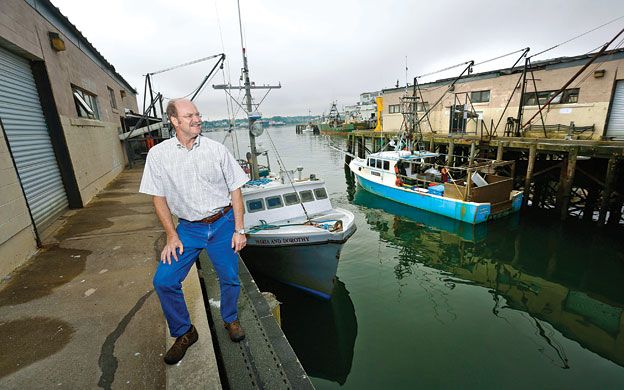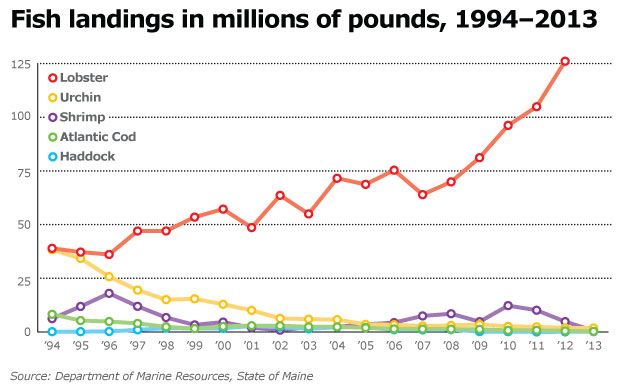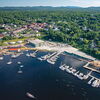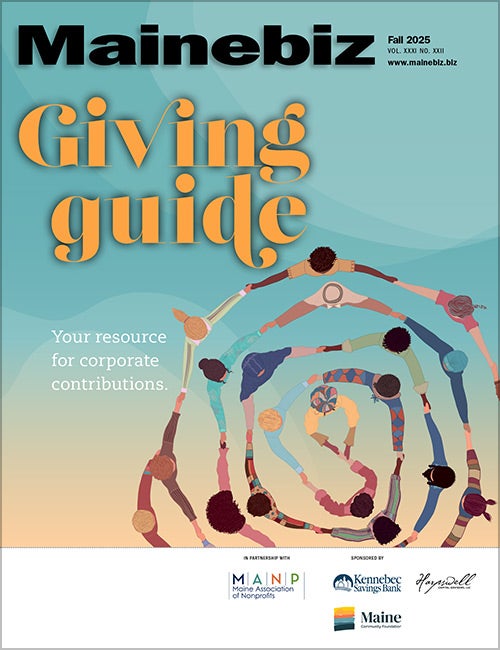Groundfishing aground? The rise and fall of Maine's offshore fishing industry
Inside the Portland Fish Exchange's cavernous warehouse on a hot summer's morning it's unseasonably cold, 38 degrees Fahrenheit according to a wall thermometer. An hour before the start of that day's auction, graders walk makeshift aisles of totes filled with iced fish that were offloaded in the early morning, sorted by species, size and quality and tagged with bar codes that tell buyers when the catch was landed and the boat that brought it in.
At 22,000 square feet it's one of the largest refrigerated warehouses in the state, the staging area where 90% of Maine's catch of fresh cod, dabs (lemon sole), flounder, haddock, hake, halibut, Maine shrimp, monkfish, pollock, redfish, skate, swordfish and tuna is displayed for buyers who'll make their bids electronically in an Internet auction that occurs at 11 a.m., Sunday through Thursday. Twenty years ago, the totes would have filled the warehouse. Now they take up less than one-third of the space.
“I was here from 1989-1996, when we opened up at 4 a.m. and sometimes ran until midnight,” says General Manager Bert Jongerden, who returned in 2007 to run the all-display fresh seafood auction that opened in 1986 and quickly became the model for similar auctions in New Bedford and Gloucester in Massachusetts. “Back then, when we did 30 million pounds of fish, we had close to 65 people working here. From 1990 to 2003 or 2004, we were the No. 1 port on the East Coast for groundfish.”
Now, Portland is a distant third behind New Bedford and Gloucester.
The reasons are many, but Jongerden says the Portland Fish Exchange's fortunes very much have mirrored the rise and fall of New England's offshore fishing industry over the past 30 years.
When it opened in 1986 as a nonprofit, quasi-public corporation, Jongerden says, the exchange quickly capitalized on the resurgence of Maine's commercial groundfish industry. Growth was spurred by government programs encouraging investments in offshore vessels following the Magnuson Act of 1976, which prohibited foreign vessels from fishing within 200 miles of U.S. shores. By the early 1980s, Maine's offshore fleet grew to more than 300 vessels and fish landings peaked at 80 million pounds.
As the country's first all-display fresh auction, Portland quickly captured most of Maine's groundfish landings as well as some from southern New England. Instead of having to buy a boatload of fish sight unseen, it gave buyers the opportunity to see each day's catch and bid on the best-quality fish. Sellers, particularly those who delivered quality fish, benefited by receiving higher prices in the auction.
“I think the people who came up with this concept got it right,” Jongerden says. “Everyone benefits because we're a nonprofit and a taxpayer-supported facility. Our fees have not changed since 2005. We don't have shareholders demanding a dividend check every three months. If it was a private, for-profit business, this would be a whole different operation down here.”
By 1994, however, yearly groundfish landings and the number of vessels had fallen sharply from peak levels of the prior decade. The contraction of New England's offshore fishing industry was well under way, with the federal government playing an ever-greater role through a succession of measures designed to better manage depleted groundfish stocks. The Magnuson Act underwent two major revisions — the Sustainable Fisheries Act of 1996 and the Fishery Conservation and Management Reauthorization Act of 2006 — that established fleet quotas, gear restrictions, days-at-sea limitations and quotas in an effort to better manage and even rebuild key species — cod, haddock and flounder.
Jongerden acknowledges the debate has often been highly contentious between fishermen and the marine scientists, environmental groups and state and federal regulatory bodies crafting the rules impacting their livelihoods. “With the closed areas and all the rules, it makes my head hurt to see what these guys have to do [to stay in business],” he says. “A lot of the boat owners are under tremendous economic pressure.”
In 2003, then-Gov. John Baldacci created a task force of the various stakeholders and gave them the daunting task of saving Maine's beleaguered groundfish industry from total collapse. The task force's 2004 report essentially framed the challenge as a Catch-22, characterizing the latest federal regulations as necessary to rebuild the depleted groundfish stocks but also noting that the slow pace of restoring the fisheries' health “threatens to decimate the Maine commercial fishing industry before the rebuilding targets are achieved.”
The task force reported that Maine's annual groundfish harvest had dropped from 80 million pounds in the early 1980s to less than 20 million in 2004. Dozens of vessels and seafood processors had gone out of business and the remaining ones were just barely hanging on. It singled out the Portland Fish Exchange as a linchpin to the future of the state's groundfish industry.
“Lack of fish or sporadic supply could lead to the collapse of the Portland Fish Exchange,” its 2004 report stated. “Loss of the Portland Fish Exchange would force vessels to make private sales with processors, putting some harvesters at a disadvantage in negotiations and forcing prices lower than they are with the current auction system. Loss of the Portland Fish Exchange would force Maine vessels to truck their product out of state to be sold and would also remove a critical incentive for vessels to fish from Maine ports.”
Jongerden says the Portland exchange has had to innovate, as well as tighten its belt, to stay in business during a prolonged period of decreased groundfish landings. Its payroll has been cut by nearly 70% from early 1990s levels and it now leases one third of its refrigerated warehouse to a seafood company for the storage of lobster bait. Ping-pong paddles with numbers that had been used for 22 years to signal bids now hang from the warehouse wall; they've been replaced by auctions that since 2008 have been done electronically over the Internet, with buyers bidding via one of the computers in the glassed room next to the warehouse or online from a remote location.
“That's when we really started downsizing,” Jongerden says, noting that the electronic auction coincided with a streamlining of data processes that now take place right on the docks when fresh-caught fish are hauled out of the boats and assigned bar codes that are both tagged to the ice-filled totes and entered into the exchange's private computer network for viewing by qualified buyers and sellers.
Annual landings at the Portland Fish Exchange have averaged between 5 million and 6 million pounds of fish for the past three years. “I think the offshore fishery has stabilized,” Jongerden says. “I'm pretty confident we're going to see some of our landings go up this year.”
He quickly adds that they'd be much higher if the state would scrap a law that now prohibits offshore fishermen from selling in Maine any by-catch lobsters — an estimated 100,000 pounds annually, or less than 1% of the state's yearly lobster landings — hauled up in nets. Massachusetts has no such prohibition, which he says has been a big reason why a dozen or more Maine boats bring their catch to Gloucester instead of Portland.
“Our landings would increase annually by 5 million to 10 million pounds immediately,” he says, noting that efforts to change the law have been repeatedly blocked in the Legislature by the lobbying efforts of the lobster industry. “The only way this change would every have a prayer of happening is to have a statewide referendum.”
Jongerden concedes it's hard to be optimistic about the future of Maine's groundfish industry. Part of the answer, he says, is for consumers to ask for fresh Maine-caught fish when they go to the supermarket or restaurant.
“The benefit,” he says, “is that some of that money is going to trickle back to the fishermen.”
Read more
'He wheeled and dealed': An interview with Mainebiz founder Jon Whitney
Maine's mix of colleges and universities have created an 'education hub'
Mergers and regulations: Two decades of change in banking
Health care crossroads: Rising costs coupled with need to be affordable
Oil, propane expected to remain stalwarts as Mainers try new energy sources
Growth engine: Faster broadband seen as essential for Maine's economy
Forest products industry puts $8 billion into Maine's economy
Know your farmer: Locally sourced food trend buoys Maine farms
An industry, changed but still viable: One man's tale of Maine manufacturing
Decades of tide changes: Investments help Bath Iron Works maintain its shipbuilding prowess
Reflecting on 20 years: Other 20-year-old companies look back
Mainebiz presents a 20-year retrospective of doing business in Maine
'He wheeled and dealed': An interview with Mainebiz founder Jon Whitney
Mergers and regulations: Two decades of change in banking
Health care crossroads: Rising costs coupled with need to be affordable
Oil, propane expected to remain stalwarts as Mainers try new energy sources
Growth engine: Faster broadband seen as essential for Maine's economy
Forest products industry puts $8 billion into Maine's economy
Know your farmer: Locally sourced food trend buoys Maine farms
An industry, changed but still viable: One man's tale of Maine manufacturing
Decades of tide changes: Investments help Bath Iron Works maintain its shipbuilding prowess
Reflecting on 20 years: Other 20-year-old companies look back
Mainebiz presents a 20-year retrospective of doing business in Maine
Two bays closed for scallop harvesting












Comments